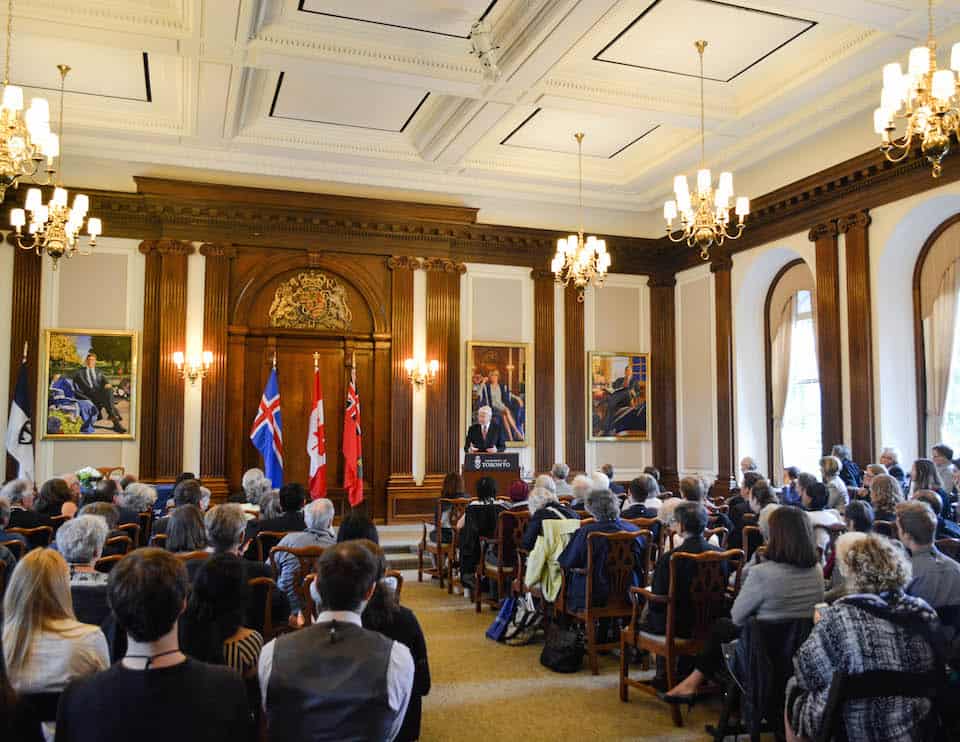On June 12, during a talk addressing the issues surrounding “The Arctic and Himalayas: New Models of Cooperation,” Icelandic president Ólafur Ragnar Grímsson, spoke to a small audience at the Governing Council chamber on the urgent need for the global community to take part in a dialogue regarding the future of ice in our world.
The hour-long keynote address by the fifth president of the Republic of Iceland was a part of his initiative to bring countries together in an effort to highlight the importance of protecting the regions of the world that are quickly disappearing. The Arctic Council (comprised of: Canada, Denmark, Finland, Iceland, Norway, Russia, Sweden, and the US) has exchanged scientific information about global warming patterns since 1996, and now, within the past few years, other members of the political community are recognizing their duty to interact with the arctic states and to take measures to prevent environmental degradation. Grimsson emphasized that this is a matter of global importance saying, that “the main areas of the planet where the interactions between ice and people will have a fundamental consequence, not only on the arctic and Himalayas but on every continent and every country in the world.”
The statement veracity is reflected in the recent interactions Grímsson has had with countries like China, Singapore, India, and Bhutan. Chinese scientists are flooded with evidence that the melting of the arctic sea ice forces extreme weather patterns; and according to Grímsson, Singaporean leaders are becoming actively engaged with the future of the arctic, he explained that, “if only a quarter of the Greenland ice sheet melts, Singapore, as they know it, will no longer exist.” India, as well, is working with Iceland to collect information from neighbouring countries on the Himalayan region; and in February of 2015, Bhutan successfully lead a three-day conference about the consequences posed by retreating glaciers in the Himalayas. The purpose of the conference was to highlight the importance of controlling the impact that retreating glaciers will have on daily life. Unfortunately, to date, there has not been any systematic cooperation between the countries that are heavily reliant on the water from the Himalayas due, in large part, to historical conflicts and tensions.
In light of the increasing popularity of global leaders wishing to participate in the discussion about the arctic, the council has established a four dimensional model inviting Indigenous, North American, Asian, and European scientists, students, activists, and politicians to join an annual Icelandic conference. The gatherings are a new and important step to fully understanding what we once believed to be a frozen, and unchanging arctic world. These same steps have not occurred with regards to the Himalayan region. Knowledge surrounding the Himalayas is scarce, and it is limited because of the incredible difficulty involved in bringing scientists together from countries like China, India, Pakistan, Nepal and Bhutan. There is an alarming lack of research about the area, so much so that the term “white spots” has been used to describe the blank, academically untouched land.
Around one-third of the world’s population depends on the rivers in the Himalayan region for food security, yet very little is known about how to regulate the snow, ice, and flowing waters of this region. Grímsson predicts that, “in twenty years’ time, about thirty per cent of the Himalayan reserve will disappear, when my grandchildren will be in their prime, it’ll reach about fifty per cent, and at the beginning of the twenty-second century, about seventy-five per cent of the Himalayan glaciers will melt.”
It is easier said than done, but ideally the international community will set aside their differences to drive scientific research forward, or at least try to take steps towards that. President Grímsson closed his speech saying, that “the excuse: ‘it doesn’t matter what I do’ is no longer viable, because the effect of what we do in the next 20 years will be monumental for the rest of the century and for the century to come. Is it possible? I believe so, that’s why I’m here.”


